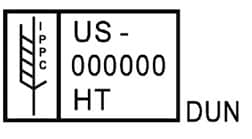What is Dunnage and How is it Involved in Export Packaging?
Have you heard of the Asian Giant Hornet? In common parlance, it’s called the “murder hornet”—and if you haven’t heard of it I bet you don’t want to! It’s the largest hornet in the world, 4 times bigger than a honey bee, and its stinger can pierce regular bee suits. They aren’t called “murder” hornets for nothing.
These nightmare-provoking hornets were discovered in the pacific northwest in the summer months of 2021 and residents were understandably concerned. Luckily, it seems as if the population of murder hornets is mostly under control due to a massive mobilization of entomologists (pest experts) to eradicate them.
You might be thinking, what does the murder hornet have to do with dunnage and export packaging?
Murder hornets most likely arrived in North America in shipping containers. There is a long history of pests arriving on container ships and wreaking havoc in North America or wherever else they happen to land. Asian long horn beetles have destroyed millions of trees in North America. Dutch Elm’s Disease has nearly eradicated elm trees in North America. The list goes on, and there are similar invasions in other continents. When we talk about Export Packaging, what we are really talking about is preventing invasive pests from entering ecological systems that aren’t adapted to handle them.
What is Export Packaging?
Export Packaging refers to packaging that is used to ship items from one country to another. Because of the risks of invasive species, there is an international convention that determines best practices and governs their implementation. This is called International Plant Protection Convention, or IPPC for short. The IPPC implemented the “bug stamp” or ISPM stamp, that denotes that wood used in packaging has been treated to eradicate any invasive pests before it arrives at a port in a different country.
We wrote an article about the bug stamp and its history before. If you read that article, you can learn the different ways that wood has to be treated and marked in order to be safely accepted at international ports. In that article we mentioned something in passing – dunnage – that we want to spend more time on because there is some confusion about what dunnage is and why it’s an important part of export packaging.
What is “Dunnage”?
Dunnage is a general term that refers to material that is involved in a transportation journey but isn’t the packaging itself. Dunnage may be used outside a crate to secure it (by blocking and bracing) to a shipping container. Or dunnage may be inside a crate, to prevent the item in the crate from moving around.
In general, in export packaging, dunnage is outside the crate, but in Mil-Spec packaging dunnage is inside the crate, sometimes referred to as “military returnable dunnage” and crates are often stenciled “REUSABLE CONTAINER DUNNAGE DO NOT DESTROY”.
The ISPM Dunnage Stamp
When shipping a product overseas, typically you will have a crate that needs to go inside of a shipping container. The crate itself is understood as a “kit” that makes up all the parts of the crate including any loose wood used to support or secure items inside the crate. The kit will need to have the ISPM bug stamp on each side, so it is clearly legible to the authorities at the port of call.
When a packager like us makes a kit we must certify that every piece of solid wood in the kit is treated to be ISPM compliant. It is our responsibility to ensure that’s the case. So even if the bug stamp doesn’t appear on every last piece of wood, the whole kit is considered compliant.
Along with the crate kit, we will often ship some dunnage as well. This way the client or transporter can block and brace the crate with treated wood as well. Dunnage has a different stamp, the ISPM DUN stamp. When the crate gets blocked and braced against the walls of a shipping container, all the wood that is not directly part of the crate will need a clearly visible DUN stamp. This ensures that the lose wood outside the crate isn’t carrying any pests and the shipping container won’t be stopped at port.
To re-cap, the crate kit itself needs an ISPM bug stamp. And everything that isn’t directly part of the crate needs an ISPM DUN stamp. Even when there is no crate and equipment is just being loaded into a sea container, any solid wood used to secure the equipment (block and/or brace) inside the container needs an ISPM DUN stamp on every piece.
Don’t ship without it.
As we’ve already discussed, the penalties for shipping items without properly treated and clearly marked lumber are high. This can result in steep fines and delays, and can sometimes even result in having the items sent back at your cost. So getting ISPM bug stamps and DUN stamps right is something you can’t afford to overlook.
Let us know if you need help getting your items ready for overseas shipment. We’re happy to provide export crating kits and dunnage for any journey. Contact us to find out how we can help.



